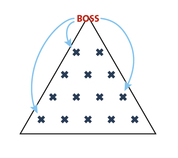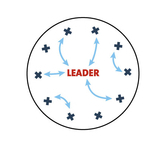What is the chain of command in your nonprofit organization?
A reader asks, “Where can I find the chain of command from the chairperson on down?” Several thoughts come to mind. This article covers nonprofit organizations—governmental bodies are different.
A nonprofit organization is not like a profit corporation


This article discusses the difference between an accountability hierarchy and a voluntary association, and what that means for meetings.
Usually the leader of a voluntary association has administrative duties defined in the bylaws. Administrative duties are different from leading the board of directors during its meetings. Sometimes the board leader may also serve as the head of the organization—for example, the chair of the board of a nonprofit may also serve as the CEO (we don’t recommend this).
You can read the articles of incorporation and bylaws to find out what kind of organization you belong to. You should also read the state laws and regulations pertaining to your type of organization, since your authority documents must conform to state law. Read this article for suggestions about how to learn about state law.
Major types of nonprofit organization
Member-governed. The membership is the final authority in this organization. Members elect the board of directors, and also have the authority to take action. The board of directors may take action between meetings of the members, as authorized in the bylaws, but may not overrule membership decisions. Small organizations and unions sometimes have this structure. The members, acting by majority vote at a properly-called meeting, are in command of the organization. This type of organization may also be called “member-driven.”
Member organization that is board-governed. The membership elects the board in this organization, and then the board governs. Some actions may be reserved to the members in the bylaws, such as voting to approve the budget, but almost all decisions are taken by the board. The board directors will, if they are wise, listen to the members, but the members may not overrule board decisions. It is common for state law to give extensive power to the board in this type of organization. The board, acting by majority vote at a properly-called meeting, is in command of the organization.
Most homeowner associations and condominiums are of this type. The board may schedule a “member forum” to hear from the owners, but the board is in command. The owner/members do not have a say in what happens at board meetings, and must sit there in silence. This is understandably frustrating to many owners!
Non-member organization with a self-perpetuating board. In this organization, once the board is established, it chooses its replacements. It is therefore “self-perpetuating.” A nonprofit of this type may allow people to become “members,” but these “members” do not have governing power or voting rights. They simply make a financial donation to support the organization. Museums and other charitable organizations often fit this category. The “members” are stakeholders, but the board, acting by majority vote at a properly-called meeting, is in command of the organization.
Committees
Executive committee. When a large organization is structured to have a board of directors, it may also create an “executive committee” made up of a smaller group of directors—perhaps just the officers, or the officers and a few board directors. The powers of this committee must be defined in the bylaws. Does it have the power to act between board meetings?
Ordinarily such a committee is ultimately subordinate to the board of directors—as it should be. However, sometimes in practice an executive committee takes the bit between its teeth and charges ahead on its own. Clarity in the bylaws about what the executive committee can and can’t do is essential. Read our article here for more on this. Usually, the board is in command of the executive committee.
Chair of committee. Under Robert’s Rules of Order, committees are a different type of body than governing bodies such as boards of directors. The chair of any committee takes a leading role in running the meetings and directing the work of the committee. The chair may even take minutes, which is not allowed to the leader of a governing board. However, the chair is not the boss of the committee and its work. It is the committee itself which, by majority vote, will take decisions and act, under the terms of its charter or mandate. The body that appoints the committee is ordinarily in command of the committee.
Read more about committees and get our free paper at this link.

